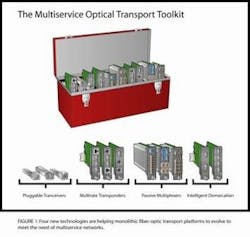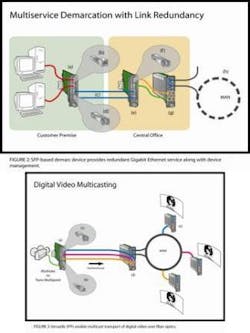The no-pain way to multi-service optical transport
Pluggable optics, pared with other enabling technologies, add flexibility to metro and sub-metro networks.
By Sergiu Rotenstein and Troy Larsen
MRV Communications
Optical transport platforms from the metro and sub-metro network to the access network and enterprise network have traditionally come in the form of monolithic -- and very expensive -- systems designed and configured for a specific application. WDM platforms have stand as a prime example of this type of architecture, where the protocols, lambdas, media, and optical budgets have remained essentially fixed.
Altering one of those characteristics has historically required either the costly replacement of an entire transponder; the implementation of an intermediary device such as a media converter, optical amplifier, or optical attenuator; or the use of costly equipment such as tunable lasers. Consequently, the barrier to deploying a true multiservice optical network with these inflexible systems has remained high, and the mixing and matching of evolving services and the integration of these services from end-to-end across the provider network have continued to be both challenging and cost-prohibitive.
Pluggable optics such as SFPs and XFPs challenge this paradigm by separating the network interface from the optical transport platform. Now the questions of protocol, lambda, media, and distance are answered with a small, comparatively cheap component that is independent of the optical transport platform and can be easily changed at any time. What supports OC-3 today can support Gigabit Ethernet tomorrow. What traveled 20 km can now travel 120 km. What operated at a wavelength of 1310 nm can now operate at channel 20 (1561.419 nm) of the ITU DWDM grid.
Now any pluggable optic-enabled device -- be it the DWDM platform of the metro network, CWDM platform of the sub metro network, or demarcation device at the customer site -- can assume the role of media converter, distance extender, or lambda converter.
Driven by the flexibility of pluggable optics in combination with passive mux/demux technology, passive optical add/drop multiplexer (OADM) technology, and multirate transponders, a single optical service platform can handle a wide range of applications and can be easily and cost-effectively reconfigured to meet changing demands. True multi service optical networks thus are now an obtainable reality.
This article will define the different elements of a multiservice optical transport platform and provide example applications that demonstrate how these elements can be used to deploy an efficient and flexible optical network capable of meeting the dynamic needs of the carrier market.
The multiservice optical transport toolkit
The basic components or "tools" for building a multiservice optical transport network can be broken down into four general categories (Figure 1).
Pluggable Transceivers: Pluggable transceivers and the devices that use them are the keys to deploying a multiservice optical network. SFP and XFP technology offer compelling advantages over fixed optical interfaces. First, they enable unmatched deployment flexibility. The same pluggable-enabled transponder can be used for multimode, singlemode, and single-fiber connections, or even for lambda-specific CWDM or DWDM connections, all simply depending upon the optical transceiver plugged into it at the moment. The advent of copper-interface pluggables, such as 10/100/1000Base-TX SFPs, extends even further this media conversion advantage.
With transmission distances of more than 120 km or greater, pluggable transceivers easily cover the typical metro network area. They are available for virtually all protocols in use today in a variety of interface types and in both "gray" and "colored" optics. Multirate pluggables -- some with supported data-rate ranges as wide as 100 Mbits/sec to 2.7 Gbits/sec -- open a whole new level of in-service flexibility, providing the ability to upgrade line rates without truck rolls to swap out equipment.
The hot-swappable, plug-and-play nature of pluggable transceivers means that, when needed, an interface can be changed quickly and easily with minimal interruption to service. Pluggable transceivers greatly reduce the need for spares inventory. Instead of requiring complete duplication of each application-specific line card, an entire service network could be covered with one line card and a small selection of pluggable transceivers covering the range of applications in use.
Multirate Pluggable-Optics Transponders: Time was when transponders, like optics, were designed and configured for a specific service. Upgrading a connection from OC-3 to OC-12 meant swapping out line cards. Today there are transponders that can support a wide range -- from 100 Mbit/sec to more than 4 Gbits/sec -- of protocol speeds. With multirate transponder line cards the transition from protocol to protocol or from service to service becomes as easy as selecting the desired data rate through device management.
Combined with support for pluggable optics, multirate pluggable-optics transponders enable the implementation of an extremely wide range of optical transport functions. They can serve as a media converter to connect network segments of different media types, or even as a lambda converter to connect network elements operating at different wavelengths. For example, using the applicable pluggable transceiver, a Gigabit Ethernet multimode link operating at 850 nm can be connected to a singlemode link operating at 1550 nm. The exact same line card could just as easily be configured with long-haul optics and be deployed as a repeater in a SONET/SDH link spanning hundreds of kilometers.
Configured with wavelength-specific pluggable optics and connected to a WDM, a multirate transponder can be used to create a static trunk WDM system, a trunk switching WDM system, or a WDM repeater with or without lambda conversion. Deployed along a WDM trunk at demarcation points, it can also be used to create a sophisticated add/drop topology.
Passive Optical Multiplexers: There are several advantages to using standalone passive WDM and OADM units in an optical transport network. Being both protocol and topology independent, their operation remains transparent to both the network and the end user.
The transparent operation of passive optical multiplexers and their plug-and-play nature lead to significant flexibility in terms of network deployment and migration. With passive multiplexers, lambda aggregation and separation is abstracted from the underlying data services, making it much easier to mix-and-match multiple services during transport across the MAN.
A simple but powerful feature of passive WDM and OADM components is that they have no power requirement, which means that they can be placed virtually anywhere and will not suffer the effects of potential power outages.
Passive WDM and OADM devices can today be found for CWDM as well as DWDM applications. Approximate insertion losses associated with passive optical multiplexers can be as low as 1 dB or as high as 5 dB. The advantage of using pluggable transceivers as the transponder that feeds into a passive multiplexer is that it becomes a trivial matter to swap the optics as needed to achieve the necessary end-to-end link budget.
Intelligent Demarcation: In the user data sense, demarcation is where the rubber meets the road. It is where the transport network of the metro or sub-metro ends and begins. It is where the various user-subscribed services are defined and implemented. Accordingly, there are a wide range of demarcation devices that run the gamut from 802.3ah-enabled single-service devices to multiservice devices that may, for example, use TDM to combine WAN (one or more T1/E1 or DS3/E3 aggregated voice channels) along with an Ethernet data channel. At the top end of the demarcation pyramid are devices that incorporate advanced services such as quality-of-service controls, virtual LAN tagging, and even MPLS.
However, whatever the services provided, in terms of multiservice optical transport it is essential that the demarcation device support pluggable transceivers for connecting to the carrier network. Having this feature takes the benefits of optical transport flexibility and serviceability out to the edge of the provider network and makes the task of aggregation and grooming at the central office (CO) that much easier.
Example applications
Pluggable optics and the related technologies we've discussed combine to provide flexibility and increase capabilities in a variety of network applications, as these two examples illustrate.
Multiservice Demarcation with Link Redundancy: In this example (Figure 2), a multi-service demarcation device (a) that uses TDM combines two Gigabit Ethernet (GbE) channels onto a single link, and also inserts a sideband 802.3ah OAM channel. The subscriber side of the device accommodates SFP pluggable transceivers, enabling the user to directly configure the interfaces with copper 1000Base-TX SFPs (b).
The customer in this case requires 1+1 link redundancy to the CO (c), which this particular demarcation device supports through its dual CO-side SFP ports. Making use of bidirectional single-fiber SFPs (d), the service provider is able to fulfill the requirement using only one pair of fibers.
At the CO, the two GbE channels are separated out and the OAM channel processed by a "bookend" transponder (f), which retransmits each GbE channel, using wavelength-specific SFPs (g). The colored wavelengths are passed through a passive optical mux/demux (h) that adds them to the sub-metro network.
Digital Video Multicasting: The transport of digital video (SDI, HD-SDI, etc.) across an optical network has presented a unique challenge due to the pathological signaling nature of the encoding schemes used. Overcoming this obstacle generally requires a highly specialized line card configured with DC-coupled fixed optical transceivers. However, as an example of the growing versatility of pluggable optics and the multiservice optical transport toolkit, an HD-SDI video signal can now be multicasted unidirectionally across an optical transport network (Figure 3).
The video source is connected directly to a crossbar transponder (a), in essence a small physical layer switch capable of duplicating an incoming signal across multiple ports. The input port on the transponder is configured with an SFP (b) designed specifically to deal with the pathological signaling of SDI, and which provides a standard BNC copper interface.
The transponder duplicates the video signal in real time and simultaneously transmits it out three ports, each of which is configured with a WDM wavelength-specific SFP (c). From there the signals are multiplexed through a passive WDM (d) and added to the metro ring by way of a three-channel OADM (e).
One by one, each of the three video channels is dropped to its destination by OADM (f). At each site a multirate transponder acts as a demarcation device in that it converts the video signal back into native SDI format.
Bringing it all together
Pluggable transceivers together with multirate transponders, passive optical multiplexers, and intelligent demarcation devices make multi service optical networks an obtainable reality. Today, a single optical transport platform can perform a myriad of functions from WDM and lambda conversion to media conversion and fiber optimization, making it possible for different protocols and services to easily coexist in the metro and sub-metro network.
As the variety of pluggable transceivers continues to expand, and the capabilities of transponders and other supporting components continue to improve, so too will the opportunities for advancing the services provided across the world's ever-growing fiber infrastructure.
Troy Larsen is product marketing manager and Sergiu Rotenstein is vice president, Chatsworth Division, at MRV Communications (Chatsworth, CA).


